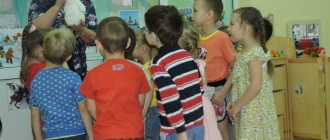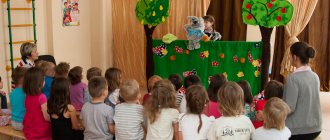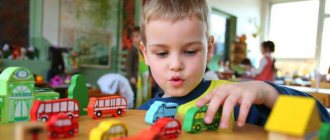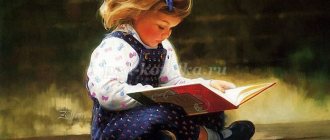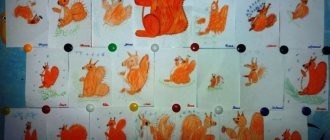Lesson summary on forming a holistic picture of the world
Tasks:
Educational.
Give children the concept of facial expressions. Teach children to determine a person’s mood and state by facial expressions. Continue to acquaint children with the distinctive features of humans and living beings: they grow and develop.
Exercise children in the ability to compare themselves and others with other people.
Continue to introduce children to photography.
Expand children's knowledge about names: do they change throughout life?
Developmental.
To develop the mental activity of children, teaching them to draw simple conclusions. Continue to teach children to answer questions with complete answers, to describe their mood using a diagram, and their character using their voice.
Develop observation skills.
Educational.
Cultivate interest in yourself and a friendly attitude towards others.
Materials and equipment: doll, flannelgraph, figurines, camera, pencils, pieces of paper, albums, photographs.
Progress of the lesson.
Children enter the hall, greet those present, and approach the teacher (in front of the children there is a children’s high chair on which sits the Katya doll familiar to the children).
Educator. - Children, look how many guests we have today. Well done, everyone greeted the guests, now pay attention to the chair. Who is this?
Children. - This is a Katya doll.
Educator. - That's right, children, this is our doll Katya, we have been playing with her for a long time, since the younger group. Today she came to us again. Children, what is the difference between a doll and a newly born child?
Children. – The doll is not alive, but the child is alive, he moves, screams, cries, grows.
“The child needs to be bathed and fed, otherwise he won’t survive and will get sick.”
– The doll is empty inside, but the child has many different organs: stomach, brains, bones, liver, blood.
“You can do whatever you want with a doll, but the child has his own character, he may not agree.”
Educator. – That’s right, children, it’s difficult with a child, but it’s interesting: to see how he grows and changes.
Do you remember how little you were?
Children. - No.
Educator. – Would you like to see yourself little now?
Children. - Yes.
Educator. - Children, who knows what we can do this with?
Children. – This can be done using photography.
Educator. – Of course, photographs will help us. Where are photographs stored at home?
Children. - In the family album.
Educator. – Every home, every family has family albums. Why do you think they store photographs and collect them in an album?
Children. – We keep photographs so that we can see how small we were when we grow up.
– To remember those people who have already died.
– To remember relatives who do not live with us.
– To watch and remember some event, holiday.
Educator. - That’s right, children, our memory cannot retain everything that happened in life. And sometimes you really want to remember what you were like, what has changed over the years, remember your family and friends who do not live next to you, some events in your life.
I took these photos from Ilyusha’s family album. Let's look at this photo. When do you think Ilyusha was photographed? How old was he? etc.
(At first, the photographs are looked at randomly, and then the teacher suggests arranging them as Ilyusha grew up. Children arrange the photographs on a typesetting canvas.)
Educator. – Now you see what our Ilyusha was like and what he became. What was the most important thing that happened to him during this time?
Children. - He grew up.
Educator. – Will it continue to grow? Grow up?
Children. - Yes.
Educator. – What are we going to call him?
Children. – Ilyusha will grow up and go to school, he will be called a schoolboy.
– Then Ilyusha will go to school, institute, technical school and he will be called a student.
“Then Ilyusha will work, and he will be called a worker or an employee.
“Then Ilyusha will grow old, retire, and they will call him a pensioner.”
Educator. – What a long, long line of life it turned out to be from birth to old age.
Who else has such a long, long life line? Who is born, grows up, ages?
Children. – Plants, animals, birds, insects.
Educator. - What does it look like?
Children. - For a flip book, for a filmstrip, for a long train.
Educator. – That’s right, children, it’s like a long train; There are many carriages in it, and only those who grow can be passengers: trees, flowers, birds.
On this table there are cards depicting various objects, people, animals, insects, birds. But those who are growing up can ride in trailers. Please accommodate train passengers. Zhenya will place passengers in the first trailer. And the rest watches whether Zhenya completed the task correctly.
Child. – In the first trailer I placed: a man, a hare, a tree.
Educator. – Olya will place passengers in the second trailer.
Child. - (The child explains.)
Educator. – Nastya will place passengers in the third trailer.
Child. - (The child explains.)
Educator. “Look, children, we placed only those who are growing up on this long train.”
Educator. – Today, children, I want to take a photo of you as a souvenir. In a year you will go to school, and T.N. and I will go to school. We will look at the photo and remember you. (I take pictures.)
In the meantime, the photo will be developed, we will talk further.
Educator. – A person changes a lot with age: his height – he becomes taller, his fatness – he loses weight or gets fatter, the color of his hair, its frequency – some turn grey, and in men a bald spot forms. The face also changes - wrinkles appear. The facial expression changes. And the facial expression is called facial expressions.
It was not in vain that I told you when I was taking photographs that you should smile - it means that you are in a good mood.
Do you know that the first impression of you is formed by the way you move, how you talk or communicate, i.e. what kind of voice do you have, what kind of facial expressions do you have? We already know that facial expressions that convey mood can be depicted using diagrams.
Yesterday I asked you to look at the expression on your mother’s face when you meet her in the evening, to see if the expression on your mother’s face will change throughout the evening, why will it change?
And now, in the first diagram, convey the mood of your mother that she had when you met her, in the second, any other expression on your mother’s face during the evening.
(Children draw.)
Children. – (Explain the diagrams.)
Educator. – Now we’ll see what impression our guests get about you based on the way you move.
(Children move to the music.)
Educator. - Children, look at our doll. For as long as we have known her, her name is still Katya. Will she always be called that?
Children. - Yes.
Educator. – And you also have names. Let us now all say our names in unison.
Children. - (Pronounced.)
Educator. – What do you think, do people’s names change throughout their lives?
D. – Yes and no. The middle name is added. But my loved ones - my mother - will call me by name until I grow old. Grandma always calls mom by her first name, but at work mom is called by her first and patronymic.
Educator. - Now we’ll play with you. Imagine that I have become as small as you, and you have become as grown up and respectable as me.
What would my name be then?
Children. - Olenka, Olechka, Olyushka.
Educator. -What would your name be?
Children. – (State your first and patronymic.)
Educator. – There are many names, they are all good, it all depends on who pronounces the name and how they pronounce it. Today our favorite characters came to visit us - a mouse, a rooster and a cat. Whoever I put the cap on will turn into this hero and try to pronounce his name in his voice.
After each pronunciation, the children explain how they immediately imagined the hero (Olya seemed to them weak, defenseless, fearful, small; Misha - well-fed, important, lazy, immediately makes it clear that the mice should be afraid of him; Zhenya - proud, cocky, handsome, and wants to say “beware of me.”)
Educator. – Well done, children, with your voice you can convey the mood, character of the hero, his behavior and even his appearance.
It’s so interesting that we talked about ourselves today, but you will learn and discover a lot of new things in yourself throughout your life.
This is how our photograph appeared. Let's look at it.
